Dance in the Age of Social Media: New Forms of Expression

The Evolution of Dance Through Social Media Platforms
Social media has fundamentally changed how we express ourselves through dance. Platforms like Instagram and TikTok allow dancers to showcase their creativity in ways that were previously unimaginable. The ability to share short clips or full routines instantly connects artists with a global audience, fostering a sense of community and collaboration.
Dance is the hidden language of the soul.
This evolution has not only led to new dance styles but also to the emergence of viral dance challenges. These challenges encourage participation from individuals who may not consider themselves dancers, democratizing dance as a form of expression. As a result, the barriers between professional and amateur dancers blur, creating an inclusive environment.
Moreover, social media serves as a platform for cultural exchange, where different dance forms can influence one another. Dancers from various backgrounds share their unique styles, inspiring a rich tapestry of movement that reflects the diversity of the global community.
Viral Dance Challenges: A New Form of Expression
Viral dance challenges have taken the world by storm, captivating millions and creating a shared language of movement. From the 'Renegade' to 'Savage,' these challenges encourage users to replicate specific choreography, often set to popular songs. This phenomenon not only entertains but also unites people across different cultures and age groups.

These challenges can transform ordinary individuals into viral sensations overnight, showcasing the power of social media as a launchpad for talent. As participants engage in these trends, they add their personal flair, allowing for a unique blend of individuality and collective creativity. It’s a beautiful representation of how dance evolves through shared experiences.
Social Media Transforms Dance
Platforms like Instagram and TikTok enable dancers to share their creativity globally, fostering community and collaboration.
However, this trend also raises questions about originality and ownership in dance. With so many people sharing similar moves, the line between inspiration and imitation can become blurred. This discussion highlights the need for dancers to find their voice while contributing to the ever-changing landscape of dance.
Influencers and Professional Dancers: A Blurred Line
The rise of social media influencers has changed the landscape for professional dancers. Many dancers now leverage platforms like TikTok and Instagram to build their brands, connecting with fans and potential employers directly. This shift allows dancers to take control of their careers in ways that traditional pathways may not have allowed.
The dance is a poem of which each movement is a word.
As influencers, these dancers often collaborate with brands, creating sponsored content that showcases their skills while providing financial support. This new dynamic offers opportunities for dancers to monetize their craft, but it also challenges them to maintain authenticity in a commercial landscape. Striking this balance is essential for long-term success.
Additionally, the presence of influencers can overshadow traditional dance institutions, leading to a reevaluation of what it means to be a 'professional' dancer. The lines are increasingly blurred, presenting both opportunities and challenges for those navigating this new terrain.
The Role of Dance Communities on Social Media
Social media has given rise to vibrant dance communities that thrive on collaboration and support. These online spaces allow dancers to share tips, techniques, and encouragement, fostering a sense of belonging. Whether through dedicated dance pages or hashtags, individuals can connect with others who share their passion.
These communities often challenge the traditional notions of dance education, emphasizing accessibility and peer learning. Dancers can learn from one another, regardless of their geographical location, creating a rich resource for skill development. This democratization of knowledge empowers aspiring dancers to pursue their passion without formal training.
Viral Challenges Empower All Dancers
Dance challenges invite participation from everyone, blurring the lines between amateur and professional dancers.
Moreover, these communities can serve as a safe space for expression, allowing dancers to explore their identities and styles. By sharing their journeys, dancers inspire others to embrace their uniqueness, contributing to a culture of acceptance and creativity.
Mental Health and Dance: A Therapeutic Outlet
In today's fast-paced world, dance has emerged as a significant therapeutic outlet, especially through social media. Many individuals use dance as a way to express emotions and cope with stress, sharing their journeys online. This form of expression can be incredibly empowering, allowing people to connect with others who share similar struggles.
Social media platforms provide a space for dancers to document their mental health journeys, raising awareness about the importance of self-care and emotional well-being. By sharing vulnerability through dance, individuals can inspire others to seek help and find joy in movement. This not only highlights the therapeutic benefits of dance but also fosters a supportive community.
Additionally, many influencers and mental health advocates are using their platforms to promote dance as a means of healing. This advocacy helps to destigmatize mental health issues, encouraging open dialogue and offering resources for those in need. The fusion of dance and mental health awareness creates a powerful movement that resonates with many.
The Impact of Technology on Dance Creation
Technology has revolutionized the way we create and consume dance, providing tools that enhance our artistic expression. From digital editing software to advanced lighting and sound equipment, dancers now have the ability to elevate their performances beyond traditional settings. This integration of technology offers new avenues for creativity, allowing for innovative choreography and presentation.
Moreover, social media platforms often incorporate features that facilitate the sharing of these creative endeavors. Dancers can easily film, edit, and post their routines, reaching audiences instantly. This immediacy encourages experimentation, as artists can receive feedback and iterate on their work in real-time.
Dance as Activism and Expression
Social media amplifies dance as a powerful tool for activism, allowing dancers to address social issues and inspire change.
However, the reliance on technology can also raise concerns about authenticity and connection to the art form. Dancers must navigate the balance between technological enhancement and genuine expression, ensuring that their creativity remains at the forefront of their work.
Dance as a Form of Activism on Social Media
Dance has long been a medium for activism, and social media amplifies this powerful form of expression. Dancers use their platforms to address social issues, raise awareness, and promote change. By incorporating themes of justice and equality into their performances, they create compelling narratives that resonate with audiences.
Furthermore, viral dance trends often intersect with social movements, as seen in the choreography inspired by protests and advocacy campaigns. This blend of art and activism not only educates viewers but also mobilizes communities to take action. By harnessing the reach of social media, dancers can inspire others to join the fight for social justice.

As a result, dance becomes a vehicle for change, allowing individuals to express their beliefs while connecting with others who share their passion. This intersection of art and activism highlights the profound impact that dance can have on society, encouraging dialogue and fostering a sense of unity.